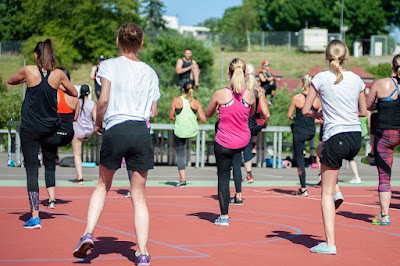Strength training might sound intimidating at first, especially if you’re new to the gym or returning after a long break. But at its core, it’s simply the practice of challenging your muscles so they grow stronger over time. Whether you’re lifting dumbbells, doing push-ups, or squatting with a resistance band, you’re strength training.
One of the most important lessons in fitness is that you don’t need to start with complex moves or heavy weights. In fact, it’s better if you don’t. Trying to skip ahead can lead to injury, burnout, or just plain frustration. Mastering the basics—like learning how to move well, breathe properly, and activate the right muscles—sets the foundation for everything else. Think of it as learning the alphabet before writing a novel.
This guide is here for you if
- You’ve never stepped foot in a gym before.
- You’re getting back into fitness after some time away.
- You want to make sure you’re doing things the right way from the start.
Wherever you’re starting from, this guide will walk you through what strength training really is, why it matters, and how to begin safely and effectively.
What Is Strength Training?
At its simplest, strength training is any exercise where you’re working against some form of resistance to make your muscles work harder. That resistance can come from weights, machines, bands, or even your own body weight (think planks, squats, and push-ups). The goal is to increase your muscle strength, tone, and endurance over time.
Let’s clear up a few common misconceptions:
- Strength training is only for bodybuilders.
Not even close. Strength training is for everyone—men and women, young and old. It’s one of the most effective ways to support your health, whether you’re looking to move better, feel stronger, or just have more energy day-to-day.
- “I don’t want to get bulky.”
Building big muscles actually takes years of dedicated training, a surplus of calories, and often a very specific genetic makeup. Most people who lift weights become leaner and more defined, not bulkier.
- “Cardio burns fat; lifting doesn’t.”
Cardio burns calories during the workout, sure. But strength training helps you build muscle, which increases the number of calories your body burns even when you’re just sitting around. It’s a powerful tool for long-term fat loss.
So why should you strength train? Here are some major benefits…
- Muscle Gain and Body Re-composition
As you challenge your muscles, they respond by growing stronger and often a bit bigger. That means more muscle tone, a firmer body, and better overall performance in everyday activities.
- Fat Loss (and keeping it off)
Strength training revs up your metabolism, especially when you build more lean muscle. That helps your body become more efficient at burning calories—even when you’re not working out.
- Stronger Bones and Joints
Resistance training puts healthy stress on your bones, encouraging them to become denser and stronger. It also helps stabilize your joints, reducing the risk of injuries and age-related bone loss.
- Improved Mental Health
Lifting weights isn’t just good for your body—it’s amazing for your mind. It reduces stress, helps manage anxiety and depression, and gives you a sense of progress that can be deeply motivating. Plus, there’s something really empowering about feeling physically strong.
Core Principles of Strength Training
Getting stronger isn’t just about showing up and lifting weights. It’s about how you train, how often, and how well you take care of your body in between. These five core principles are the foundation of every effective strength program:
1. Progressive Overload
This is the golden rule of strength training: to keep getting stronger, you need to gradually challenge your body more over time. That doesn’t mean lifting heavy every week—it could mean:
- Adding a little more weight to your lifts
- Doing one or two more reps than last week
- Taking shorter rest periods
- Improving your form or range of motion
Progress doesn’t need to be huge. Small, steady improvements lead to big changes over time.
2. Consistency
There’s no way around it—the people who get results are the ones who stick with it. You don’t need to work out every day, but showing up 2–4 times a week and staying on track over months (not just weeks) is key.
Think of strength training like brushing your teeth. Doing it regularly matters more than doing it perfectly.
3. Proper Form and Technique
Learning to lift well is more important than lifting heavy. Proper form keeps you safe, helps target the right muscles, and ensures you’re building strength efficiently.
Start light, master the movement, and only increase weight when you feel confident. Ask for help, use mirrors, or record yourself—technique always comes first.
4. Recovery and Rest
Muscles grow when you rest, not when you train. Rest days give your body time to rebuild, reduce soreness, and prevent burnout.
Aim for-
- At least one full rest day per week
- 48 hours between working the same muscle groups
- 7–9 hours of sleep per night
Listen to your body. Soreness is normal at first, but sharp pain or fatigue is a sign to slow down.
Nutrition Basics
You don’t need a perfect diet, but what you eat seriously affects your progress.
- Protein helps build and repair muscle (aim for a source in every meal)
- Carbs give you energy to lift
- Fats support hormones and overall health
- Water keeps you hydrated and helps recovery
You don’t need fancy supplements—just focus on real food and balanced meals to support your training.
Essential Strength Training Exercises
These are the big, important exercises that build the foundation of your strength. You don’t need 20 different moves—just a few great ones that work your whole body and mimic real-life movement. These are called compound exercises because they use multiple muscles at once.
Let’s go through them one by one.
1. Squat🏋️
What it is?
You bend your knees and hips to lower your body, then stand back up. Sounds simple—but it’s incredibly effective.
Why it matters?
- Builds strong legs and glutes (your butt and thighs).
- Trains your core to stabilize you.
- Helps you move better in everyday life (think sitting, standing, climbing stairs).
How to start?
Begin with just your body weight. Practice good form by pretending to sit back into a chair—feet flat, chest up, and knees tracking over your toes.
2. Deadlift🏋️♂️
What it is
You bend at your hips and knees to pick something up from the ground, then stand tall.
Why it matters?
- Strengthens your entire backside: glutes, hamstrings, back, and even your grip.
- Great for posture and lifting things safely (like groceries, boxes, kids).
How to start?
Try deadlifting with a dumbbell or kettlebell first. Keep your back straight and hinge at the hips (like closing a car door with your butt).
3. Bench Press 🛋️ (or Push-Ups)
What it is?
A pushing movement, where you lie on a bench and press a weight up, or do the same action with your body in a push-up.
Why it matters?
- Works your chest, shoulders, and triceps.
- Builds pushing strength for things like opening heavy doors or getting off the floor.
How to start?
Push-ups on the floor or against a wall are great starting points. Then try light dumbbells or a barbell when you’re ready.
4. Overhead Press🧍♂️
What it is?
You press a weight from your shoulders up over your head while standing.
Why it matters?
- Builds strong shoulders and arms.
- Trains your core to keep you balanced and upright.
- Improves shoulder mobility and control.
How to start?
Use light dumbbells or resistance bands. Don’t lean back—keep your belly tight and ribs down.
5. Pull-Ups or Rows🧗
What it is?
Pulling exercises that work your back and biceps. Pull-ups are great, but they’re tough—so rows are a solid alternative.
Why it matters?
- Balances all the pushing you do.
- Improves posture.
- Builds grip and arm strength.
How to start?
Try dumbbell or band rows, or use a machine that helps with pull-ups. Progress comes quickly with consistency.
🧠 Why These Exercises Are Foundational?
- They mimic natural movements: squatting, lifting, pushing, pulling.
- They work multiple muscles at once—saving you time.
- They help you get stronger faster with fewer exercises.
- They lay the groundwork for advanced training later on.
- If you learn and master these, you’ve got the hard part down.
Structuring a Beginner Strength Training Routine
Now that you know the what, let’s talk about the how. This is where a lot of beginners get stuck—they try to do too much, too fast. You don’t need a complex split or daily workouts. What you do need is a simple, consistent structure.
A Beginner-Friendly Weekly Plan: Full-Body 3x/Week
Why full-body? Because you hit every major muscle group multiple times a week, with plenty of rest in between. It’s efficient, simple, and effective.
Example Week
Monday: Workout A
Wednesday: Workout B
Friday: Workout A
(Switch next week so it’s B-A-B)
Workout A
1.Squat – 3 sets of 8–10 reps
2.Push (Bench Press or Push-ups) – 3×8–10
3.Pull (Dumbbell or Band Row) – 3×10–12
4.Core (Plank or Dead Bug) – 2 sets
Workout B
1.Deadlift – 3 sets of 8 reps
2.Overhead Press – 3×8–10
3.Pull (Assisted Pull-up or Row) – 3×10–12
4.Core (Leg Raises or Bird Dog) – 2 sets
You can complete each workout in about 45–60 minutes.
Reps, Sets, and Rest Time Explained
Reps (repetitions): The number of times you do the movement.
Start with 8–12 reps—it’s the sweet spot for both strength and muscle.
Sets: How many rounds of reps you do. 2–3 sets per exercise is perfect for beginners.
Rest between sets: 60–90 seconds is a good place to start. You should feel recovered but not totally cooled off.
Tips for Getting Stronger Over Time (Progression)
- Track your workouts. Just jot down your reps and weights. Seeing your progress is super motivating.
- Increase the challenge gradually. Once something feels “easy,” try adding a rep or slightly more weight.
- Don’t chase perfection. Some days feel better than others. What matters most is showing up.
- Focus on form first. Quality > quantity. Always.
Common Mistakes to Avoid
Knowing what not to do can save you weeks—or even months—of frustration or injury. Here are some classic beginner mistakes and how to avoid them.
1. Skipping Warm-Ups and Cooldowns
Why it’s a mistake: Jumping into lifts with cold muscles can cause injury.
Solution: Do 5–10 minutes of light cardio and dynamic stretches before starting. After the workout, cool down with stretching or walking.
2. Lifting Too Heavy Too Soon
Why it’s a mistake: Using too much weight too early can mess up your form and lead to injury.
Solution: Start lighter than you think you need to. Get the movement right first, then slowly increase the weight.
3. Poor Technique
Why it’s a mistake: Sloppy form reduces results and increases injury risk.
Solution: Learn the correct movement, use mirrors, record yourself, or ask someone knowledgeable to check your form.
4. Ignoring Recovery
Why it’s a mistake: Muscles need time to repair and grow stronger. Overtraining leads to fatigue and stalled progress.
Solution: Sleep at least 7–8 hours, hydrate, eat balanced meals, and take rest days seriously. You grow between workouts, not just during them.
Final Words
Starting strength training can be one of the most rewarding things you do for your body and mind. It’s not just about lifting weights—it’s about
- Moving better
- Feeling stronger
- Building confidence and taking control of your health
Keep it simple. Focus on learning. Stay consistent. The results will come.
Tools and Equipment
When starting strength training, it’s easy to get overwhelmed by all the equipment options out there—but you really don’t need much to begin. You can get stronger using just your bodyweight. Exercises like squats, push-ups, planks, and lunges can build impressive strength and control without any weights. That said, weights—like dumbbells, barbells, and resistance bands—help you progress over time by adding more resistance as your body adapts and gets stronger. The key is to choose the tools that make the most sense for your goals and environment.
Dumbbells are one of the most beginner-friendly tools. They’re versatile, easy to handle, and don’t require much space. Barbells, while more advanced, are great for lifting heavier weights and doing big compound lifts like squats and deadlifts. Resistance bands are a fantastic option too—they’re portable, gentle on the joints, and great for beginners who want to build strength gradually. Whether you train at a gym or at home, both environments can be effective. Gyms offer a wider range of equipment and support, but home workouts offer unmatched convenience and comfort. The best place to train is the one that keeps you coming back consistently.
Tracking Your Progress
Tracking your progress is one of the most underrated parts of strength training. Without some kind of log—whether it’s a notebook, app, or a notes file—you’re basically guessing your way through each workout. Writing down your sets, reps, and weights helps you stay focused and intentional. It also allows you to look back and see just how far you’ve come, which can be super motivating during slow or tough weeks.
Beginners often benefit from having general strength benchmarks in mind. For example, aiming to eventually squat your bodyweight or perform a clean set of 10–15 push-ups can provide helpful goals. These aren’t requirements or fixed timelines—everyone progresses differently. What’s more important is that you celebrate the small wins along the way. That could be doing one more rep than last week, using slightly better form, or simply showing up when you didn’t feel like it. These small victories add up and fuel long-term progress.
When to Level Up
As you build consistency and confidence with your beginner routine, you’ll likely notice that the same workouts start feeling easier. That’s a sign you’re ready to level up. You might find yourself completing your sets without much effort or not feeling as challenged afterward. This is actually a great milestone—it means you’re getting stronger. Now is the time to safely increase your weights, add more reps, or try new movements.
You can also switch from full-body workouts to split routines—like alternating upper and lower body days or trying push-pull-legs. This lets you train more frequently while giving each muscle group adequate rest. You might also consider adding some cardio or conditioning, which improves your heart health and recovery. For those ready for more structure, intermediate programs like Strong Lifts 5×5 or other evidence-based strength routines can guide your next phase. The key is to keep your training slightly challenging and engaging so your body continues to adapt and grow.
Starting a strength training journey can feel intimidating, but it’s one of the most rewarding things you can do for your body and mind. It’s not just about getting bigger muscles—it’s about feeling stronger, moving better, and showing up for yourself consistently. Mastering the basics like good form, rest, and progression lays the foundation for long-term success.
Whether you’re training at home with bodyweight or in a gym with barbells, what matters most is consistency. You don’t need a perfect plan or fancy gear to start—just the willingness to take that first step. Strength builds over time, not overnight. You’ll grow stronger by stacking small efforts week after week.
So here’s your call to action: start your strength journey today. Pick a couple of basic movements, set a simple goal for this week, and begin. It’s okay to start small. What matters is that you begin—and keep going.
Thank You For Your Time & Consideration…
@ Puja Singh…




















































